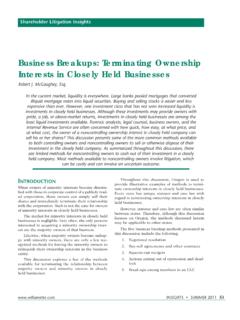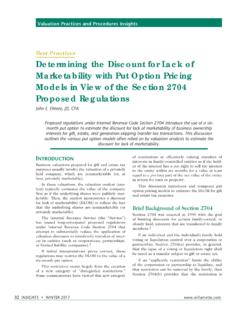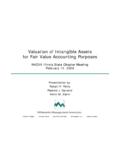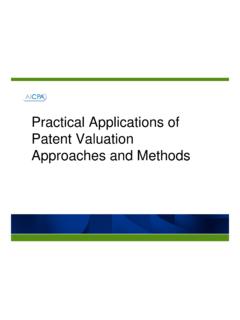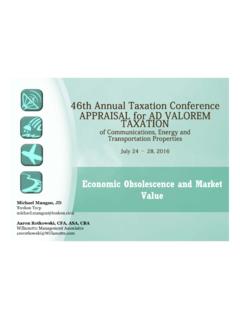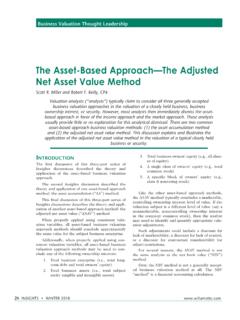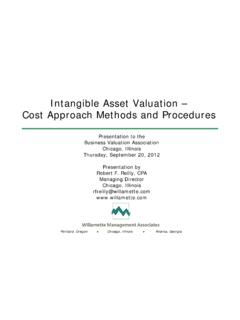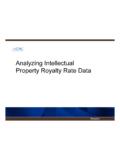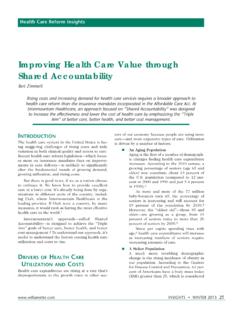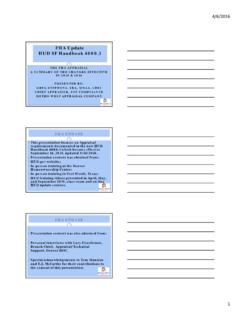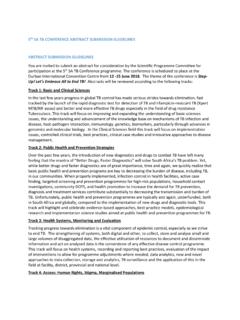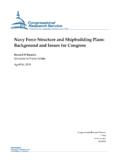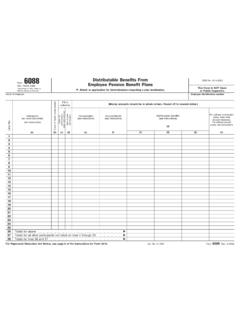Transcription of Adjusting for Underfunded Pension and …
1 Www .willamette .com INSIGHTS SUMMER 2015 67 Adjusting for Underfunded Pension and postretirement LiabilitiesChristopher W. PeiferBusiness Valuation InsightsFewer and fewer companies have Pension liabilities recorded on their balance sheets. This is because most employer companies continue to shift retirement programs to defined contribution plans such as 401(k) plans instead of traditional defined benefit Pension plans. However, a significant number of companies still provide Pension plans for their employees. Since many employer Pension plans and other postretirement benefits plans are Underfunded , to some degree, the funding status of a company s Pension and postretirement benefits should be considered as part of the business valuation number of companies with active Pension plans has steadily decreased over the last several decades.
2 In order to reduce or eliminate Pension liabilities , companies will either freeze existing postretirement benefit plans or terminate such plans in favor of defined contribution reason for this benefit plan change is to shift the primary responsibility for funding retirement from the employer corporation to the change in employee postretirement benefit plans is documented in statistics provided by the Employee Benefit Research Institute (EBRI).According to the EBRI, between 1979 and 2011, among all workers with access to employer-based retirement plans, the percentage of workers solely participating in defined benefit Pension plans declined from 62 percent in 1979, to 7 percent in the same period, the percentage of workers solely participating in defined contribution plans such as 401(k)
3 Plans increased from 16 percent in 1979, to 69 percent in , as a result of companies changing benefit plans, the percentage of workers participating in both defined benefit plans and defined contribution plans increased from 22 percent in 1979 to 24 per-cent in a Towers Watson study of retirement benefits for Fortune 500 companies, only 34 Fortune 500 companies (7 percent of all Fortune 500 companies) offered a traditional defined benefit Pension plan to newly hired salaried employees as of year-end is a substantial decrease from 251 Fortune 500 companies (just over 50 percent) in 1998, which offered traditional defined benefit Pension the same period, the number of Fortune 500 companies offering only defined contribution plans to new hires increased from 195 (39 percent) in 1998 to 382 companies (over 76 percent)
4 In January and September 2014, three of the 34 Fortune 500 companies that had offered traditional defined benefit Pension plans closed their plans to new hires and now offer only defined contribution the data from EBRI and Towers Watson reflect, defined benefit retirement plans are being supplanted by defined contribution the number of workers participating in corporate Pension plans has continued to decrease over the last several decades, a significant number of public and private corporations still have defined benefit Pension plans for plans include active defined benefit pen-sion plans, and frozen defined benefit Pension plans for existing workers that are not available to newly hired INSIGHTS SUMMER 2015 www.
5 Willamette .comMany of these plans are Underfunded , to some degree, resulting in the need to address under-funded Pension liabilities in the valuation process. Many companies also have Underfunded (or completely unfunded) postretirement health care obligations to former employees, which also should be considered in the business valuation FunDeD status oF a Pension planFor many Pension plans, the fair value of Pension plan assets is less than the projected benefit obliga-tion, resulting in an Underfunded Pension to New York University professor Aswath Damodaran, the Underfunded amount is an unfunded liability of the company.
6 And should be deducted from a company s market value of invested capital in the determination of the market value of a company s deduction of unfunded Pension liabilities from a company s market value of invested capital should be made on an after-tax order to determine Pension funding levels, deferred Pension and other postretirement benefit amounts are typically estimated by management. These estimates depend on management assump-tions that may vary widely between corporations or Pension plan adminis-trators often make general assumptions which may include the following:1. The length of time employees will work for the company2. The wages employees will earn while work-ing for the company3.
7 The life spans of employees in retirement4. The investment gains and earnings on plan assets set aside to pay Pension benefitsBased on these assumptions, corporations esti-mate the present value of expected future benefits payable to employees. Pension obligations, or pro-jected benefit obligations, are offset by Pension plan assets. Pension expense in any given year accounts for the amount of benefits earned by employees in excess of the earnings from Pension plan of the assumptions and calculations made to determine the present value of expected future benefits are done by actuaries working with compa-ny management. Based on the actuarial assumptions regarding life spans of Pension plan participants and the growth of Pension plan assets, a company s financial statements reflect the projected benefit obligation, and also the fair value of plan difference between the fair value (current market value)
8 Of a Pension plan s assets available to pay future benefits and the present value of its future obligations indicates the funded status of the Pension actuarial assumptions should be reviewed, the valuation analyst typically relies on the subject company and its actuarial consultants to determine the funded status of a Pension regard to postretirement health care benefit obligations, a company s financial statements are required to reflect the fair value of assets, if any, set aside to cover such obligations. The financial statements also reflect the present value of expected future postretirement health care benefit health care obligations are often entirely unfunded, with no assets set aside to fund the anticipated health care liabilities of covered retirees, in which case the unfunded amount is equal to the entire present value of expected ben-efit obligations to cover postretirement health care unfunded amount of the liability should be deducted, net of tax, from a company s market value of invested capital as part of the valuation process.
9 An illustrative example of a defined benefit Pension plan funding status and a postretirement benefit liabilities status is discussed status oF Pension obligations anD postretirement beneFit liabilities : Dean FooDs companyThe Dean Foods Company ( Dean Foods ) provides an example of an Underfunded Pension liability and a completely unfunded postretirement health care benefit liability. Dean Foods retirement plan is a defined benefit Pension its SEC Form 10-K filing for the fiscal year ended December 31, 2014, the actuarial assumptions used for determining the 2014 net periodic benefit cost of the Dean Foods Pension plan included the following: For many Pension plans, the fair value of Pension plan assets is less than the projected benefit obligation, resulting in an Underfunded Pension plan.
10 Www .willamette .com INSIGHTS SUMMER 2015 691. A weighted average discount rate of percent to discount future benefit costs to present value2. Expected return on plan assets of 7 percent3. A 4 percent rate of increase for employee compen-sation for the year6In its SEC Form 10-K filing for the fiscal year ended December 31, 2014, Dean Foods reported the funded status of its Pension plans and other postretirement benefit plans. The postretirement benefits are primarily health care benefits provided for former has happened with many large corpora-tions, nearly 90 percent of the Dean Foods defined benefit Pension plan obligations were frozen with regard to future participation or increases in projected benefit the effective date of the freeze, employees were transitioned to a retirement benefit based on the frozen Pension benefit and a 401(k)
